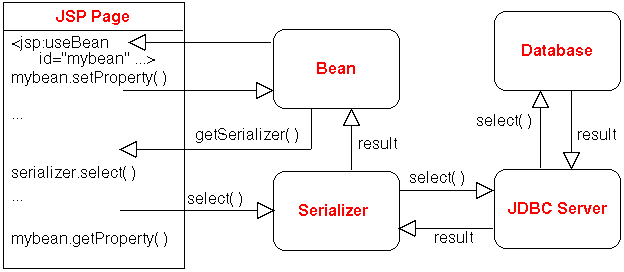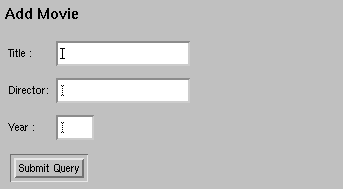This Page
Introduction
Setup
How it works
Sample Application
Acknoledgments
Questions
Jigsaw Links
JSP and Jigsaw
API
jdbcbean.jar
Related Links
JSP
tutorial
Postgresql
JDBC drivers
org.w3c.tools.jdbc package.

The system is built with some Java Beans linked to the database via a serializer (JdbcBeanSerializer). Each bean is a "mirror" of a table in the database, its properties are strictly equivalents (same name, same type) to the table colums. The serializer is in charge to build the SQL request depending on the values of the bean properties, it use a JdbcServer to send the request to the database (The JdbcServer manage a pool of persistent connections to the database). The serializer read the result and fill the bean(s) with the collected values. Then the jsp page use the serializer as an iterator and read the bean properties.
org.w3c.tools.jdbc package we're going
to create a sample application. We want to implement a search engine about
movies. So we have a database with three tables: actors,
movies and starring, we want to be able to insert
and search data in these tables. For that we'll write some jsp pages that use
some java beans.
| movieid | Title | Director | Year |
|---|---|---|---|
| 1 | 12 Monkeys | Terry Gilliam | 1995 |
CREATE TABLE movies (
movieid SERIAL NOT NULL PRIMARY KEY,
title varchar(255) NOT NULL,
director varchar(30),
year int4
)
| actorid | Firstname | Lastname |
|---|---|---|
| 1 | Bruce | Willis |
CREATE TABLE actors (
actorid SERIAL NOT NULL PRIMARY KEY,
firstname varchar(255) NOT NULL,
lastname varchar(255) NOT NULL
)
| movieid | actorid |
|---|---|
| 1 | 1 |
CREATE TABLE starring (
movieid int4,
actorid int4,
PRIMARY KEY (movieid, actorid)
)
public class MovieBean extends org.w3c.tools.jdbc.JdbcBeanAdapter {
protected int movieid = -1;
protected String title = null;
protected String director = null;
protected int year = -1;
public void setMovieid(int movieid) {
int oldvalue = this.movieid;
this.movieid = movieid;
pcs.firePropertyChange("movieid", oldvalue, movieid);
}
public int getMovieid() {
return movieid;
}
public void setTitle(String title) {
String oldvalue = this.title;
this.title = title;
pcs.firePropertyChange("title", oldvalue, title);
}
public String getTitle() {
return title;
}
public void setDirector(String director) {
String oldvalue = this.director;
this.director = director;
pcs.firePropertyChange("director", oldvalue, director);
}
public String getDirector() {
return director;
}
public void setYear(int year) {
int oldvalue = this.year;
this.year = year;
pcs.firePropertyChange("year", oldvalue, year);
}
public int getYear() {
return year;
}
}
public class ActorBean extends org.w3c.tools.jdbc.JdbcBeanAdapter {
protected int actorid = -1;
protected String firstname = null;
protected String lastname = null;
public void setActorid(int actorid) {
int oldvalue = this.actorid;
this.actorid = actorid;
pcs.firePropertyChange("actorid", oldvalue, actorid);
}
public int getActorid() {
return actorid;
}
public void setFirstname(String firstname) {
String oldvalue = this.firstname;
this.firstname = firstname;
pcs.firePropertyChange("firstname", oldvalue, firstname);
}
public String getFirstname() {
return firstname;
}
public void setLastname(String lastname) {
String oldvalue = this.lastname;
this.lastname = lastname;
pcs.firePropertyChange("lastname", oldvalue, lastname);
}
public String getLastname() {
return lastname;
}
}
public class StarringBean extends org.w3c.tools.jdbc.JdbcBeanAdapter {
protected int movieid = -1;
protected int actorid = -1;
// related beans
protected MovieBean movieBean = null;
protected ActorBean actorBean = null;
public void setMovieid(int movieid) {
int oldvalue = this.movieid;
this.movieid = movieid;
pcs.firePropertyChange("movieid", oldvalue, movieid);
}
public int getMovieid() {
return movieid;
}
public void setActorid(int actorid) {
int oldvalue = this.actorid;
this.actorid = actorid;
pcs.firePropertyChange("actorid", oldvalue, actorid);
}
public int getActorid() {
return actorid;
}
public void setMovieBean(MovieBean movieBean) {
Object old = this.movieBean;
this.movieBean = movieBean;
pcs.firePropertyChange("movieBean", old, movieBean);
}
public MovieBean getMovieBean() {
return movieBean;
}
public void setActorBean(ActorBean actorBean) {
Object old = this.actorBean;
this.actorBean = actorBean;
pcs.firePropertyChange("actorBean", old, actorBean);
}
public ActorBean getActorBean() {
return actorBean;
}
}
As you can see, the Java Beans are strictly equivalent to the table they
represents. The name of the bean properties MUST be strictly equals to
the column names in the SQL table. Note that StarringBean has two
special properties that are one ActorBean and one
MovieBean, this will be used by the JdbcBeanSerializer
to perfom SQL request on several tables at a time.
It is necessary to fire a PropertyChangeEvent each time a
property is modified (the Serializer needs it).
<jsp:useBean id="configbean"
class="org.w3c.tools.jdbc.JdbcBeanAdapter"
scope="session" >
<jsp:setProperty name="configbean"
property="jdbcDriver"
value="org.postgresql.Driver" />
<jsp:setProperty name="configbean"
property="jdbcURI"
value="jdbc:postgresql://our.db.host/ourdb" />
<jsp:setProperty name="configbean"
property="jdbcUser"
value="joeuser" />
<jsp:setProperty name="configbean"
property="jdbcPassword"
value="our password" />
</jsp:useBean>
In config.jsp we specify the common values for our jdbc
beans:
This will be used to initialize our beans.

First we initialize moviebean:
<%@ page import="org.w3c.tools.jdbc.*" %>
<%@ include file="config.jsp" %>
<!-- initialize moviebean and specify the table name "movies" -->
<jsp:useBean id="moviebean" class="MovieBean" scope="request">
<%
JdbcBeanUtil.initializeBean(configbean, moviebean, "movies");
%>
</jsp:useBean>
As you can see, the serializer is used to insert the values received during a POST request into the database.
<!-- set properties -->
<jsp:setProperty name="moviebean" property="*" />
<!-- html starts here -->
<!DOCTYPE HTML PUBLIC "-//W3C//DTD HTML 4.0 Transitional//EN">
<html>
<head>
<title>Add Movie</title>
</head>
<body>
<h1>Add Movie</h1>
<%
if (request.getMethod().equals("POST")) {
// Insert movie in database
if (moviebean.getSerializer().insert()) {
%>
Movie added!
<%
} else {
%>
SQL Error.
<%
} else {
%>
<form method="POST">
<table border="0">
<tr>
<td>Title : </td><td><input type="text" name="title"></td>
</tr><tr>
<td>Director: </td><td><input type="text" name="director"></td>
</tr><tr>
<td>Year : </td><td><input type="text" name="year" size="4"></td>
</tr><tr>
<td colspan="2"><input type="submit"></td>
</tr>
</table>
</form>
<%
}
%>
</body>
</html>
This is a sample, we should verify that all mandatory properties are
specified and valid before calling the serializer
(moviebean.getSerializer().insert()).

In the first part of the jsp page we initialize our three beans.
<%@ page import="org.w3c.tools.jdbc.*" %>
<%@ include file="config.jsp" %>
<!-- initialize moviebean and specify the table name "movies" -->
<jsp:useBean id="moviebean" class="MovieBean" scope="request">
<%
JdbcBeanUtil.initializeBean(configbean, moviebean, "movies");
%>
</jsp:useBean>
<!-- initialize actorbean and specify the table name "actors" -->
<jsp:useBean id="actorbean" class="ActorBean" scope="request">
<%
JdbcBeanUtil.initializeBean(configbean, actorbean, "actors");
%>
</jsp:useBean>
<!-- initialize starringbean and specify the table name "starrings" -->
<jsp:useBean id="starringbean" class="StarringBean" scope="request">
<%
JdbcBeanUtil.initializeBean(configbean, starringbean, "starrings");
starringBean.setMovieBean(moviebean);
starringBean.setActorBean(actorbean);
%>
</jsp:useBean>
As you can see, starringbean is associated with
moviebean and actorbean. Then moviebean
and actorbean will be automatically updated by the
starringbean serializer during the result iteration.
<!-- set properties -->
<jsp:setProperty name="actorbean" property="*" />
<!-- html starts here -->
<!DOCTYPE HTML PUBLIC "-//W3C//DTD HTML 4.0 Transitional//EN"><html>
<head>
<title>Search movies</title>
</head>
<body>
<%
if (request.getMethod().equals("POST")) {
JdbcBeanSerializer serializer = starringbean.getSerializer();
serializer.select();
if (serializer.first()) {
do {
%>
<!-- display result -->
<jsp:getProperty name="moviebean" property="title"/>,
(<jsp:getProperty name="moviebean" property="year"/>)<br>
Directed by <jsp:getProperty name="moviebean" property="director"/>
<hr>
<%
} while (serializer.next());
}
} else {
%>
<h1>Search movies starring:</h1>
<form method="POST">
<table border="0">
<tr>
<td>Actor's Firstname : </td>
<td><input type="text" name="firstname"></td>
</tr><tr>
<td>Actor's Lastname: </td>
<td><input type="text" name="lastname"></td>
</tr><tr>
<td colspan="2"><input type="submit"></td>
</tr>
</table>
</form>
<%
}
%>
<hr>
</body>
</html>